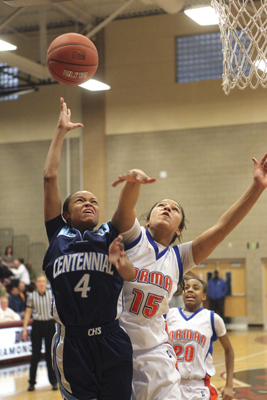4A GIRLS: Running clocks haven’t slowed Centennial, Foothill girls’ runs
Centennial’s Karen Weitz and Foothill’s Mike Collins insist their teams are ready to compete in the Class 4A girls state basketball tournament.
And they’d better be.
Both teams will face some of their stiffest competition of the season, and to win, a team will be required to play its best for 32 minutes on consecutive nights.
It’s something neither has had a ton of practice at this season.
Centennial (29-2) faces Reno (26-5) at 3 p.m. and Foothill (20-5) takes on Northern Region champion Reed (21-2) at 6:20 in Thursday’s semifinals at UNR’s Lawlor Events Center. The winners play for the title at 6 p.m. Friday at Lawlor.
For the Bulldogs, though, playing a 32-minute game is something of a foreign concept.
Before the start of this season, the Nevada Interscholastic Activities Association adopted a continuously running-clock rule when a team has a lead of 40 or more points in the second half.
Centennial had a running clock in 15 of its 16 Northwest League games, winning by an average of 45.2 points per game. And it could have been much more.
Along with the running-clock rule, the NIAA also instituted a policy that forces coaches whose teams win by 50 or more points to detail in a letter what they did to keep the game competitive. Coaches whose teams win by 50 or more face sanctions, including possible suspension and/or forfeiture of games.
The Bulldogs backed way off the gas in many of their league games, winning only two by 50 or more.
In one game, the Bulldogs didn’t score in the second half. At all. And still won by 44.
“You’re going to put a running clock in at 40, and we get there at halftime,” Weitz said. “Now you say at 50 we face suspension of coaching, you’re only giving us an eight-point leeway there. You want us to do something with eight points in two quarters. What do you want us to do with eight points in two quarters? Throw the basketball around? That’s also a mockery.
“The whole thing needs to be reviewed.”
Centennial plays an aggressive, trapping style of defense and a high-tempo offense. It’s a pace that most other Las Vegas teams struggle to match.
“To all of a sudden tell kids that they’re going to have to play a different way is not right,” Weitz said. “You can’t take the game out of the coaches’ hands. You can’t tell kids to not play hard, and that’s what they’re asking us to do, in my eyes.”
Foothill won six of its 14 Southeast League games by 40 or more — one using only the six players on the end of its bench — and two more by 37. Foothill won by 50 or more twice, including one against a team that qualified for the playoffs.
The Falcons won five league games in an 11-day stretch by margins of 45, 28, 44, 43 and 47.
“It’s difficult,” Collins said. “You’re so up and down. It creates inconsistency within your program. I don’t mind the running clock rule, but the 50-point rule is tough. Those are games when maybe you work on some things within your team, but it’s hard to keep your starters on the floor, and you can’t just work on your own things.”
Collins has told his team not to shoot at all or not to attempt a shot until after they had passed the ball 20 times.
“It’s so arbitrary,” Collins said. “Really, if you’re answering questions on a form or writing a letter, what does it do? If you have 49-point games, what’s the difference?”
The problem doesn’t exist for just two teams.
Neither the NIAA nor the Clark County School District keeps a record of how many games used a running clock, but of the 256 Class 4A girls league games played in Southern Nevada this season, 60 were decided by 40 or more points — including 11 by 50 or more.
Another 17 were decided by 35 to 39 points.
Eighteen teams, including a handful that lost by 40 or more, won a game by 40 or more, shortening the game at least a little, resulting in less playing time for players on the end of the bench.
And what time is played with the running clock usually is far from quality.
“The other part is it’s not helping the other team” get better, Collins said. “If anything, they get ticked off. You’re making a mockery of it.”
NIAA executive director Eddie Bonine, though, thinks the rule has helped.
“To my knowledge, the response has been mostly positive,” Bonine said. “I’m not sure coaches are doing everything they can do to keep the score down.”
Bonine said that a similar rule exists in football, where a running clock is used in the second half of games in which the point differential is at least 45, and in some cases winning teams have had to detail in a letter what they did to not let the game get more out of hand.
Bonine said he hasn’t suspended a coach for winning by too many points.
He’s hopeful that with realignment next season and current 4A teams being separated into two divisions that the number of games in which a running clock is used will drop.
“The discrepancy is in the South,” Bonine said. “We really haven’t had that problem in the Northern 4A. The proof will be in the pudding next year. There maybe will be some teams that still win big, but I’m hoping that what we’ve done will cut that down.”






















